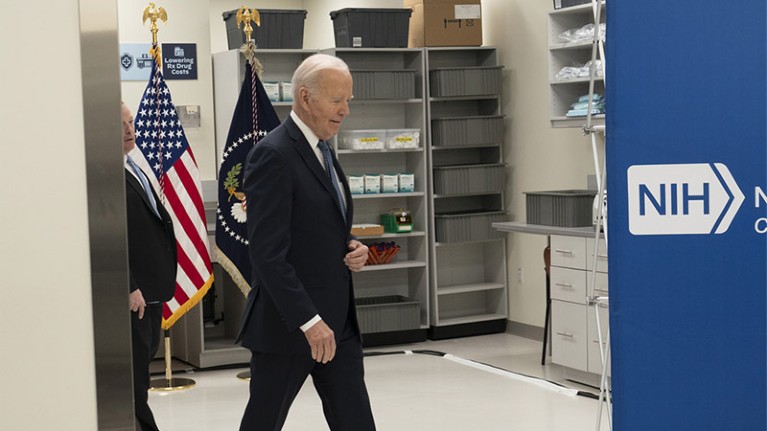[ad_1]

President Biden visits the US National Institutes of Health, which under his proposed budget would receive roughly the same amount of funding in the 2025 fiscal year as in the 2023 fiscal year.Credit: Chris Kleponis/CNP/Bloomberg via Getty
US President Joe Biden today proposed modest increases in federal spending on science and innovation for the 2025 fiscal year. But that doesn’t mean his new budget will face an enthusiastic reception in Congress, which decides how much the government will spend.
Biden, a Democrat, has sought increases for many agencies in previous years but has run up against opposition among Republicans on Capitol Hill. Biden’s spending proposals for the 2024 fiscal year, which began in October, fared no better: in June 2023, after months of sparring, Democrats and Republicans agreed to spending limits for the 2024 fiscal year ― and for the 2025 fiscal year, likely quashing hopes that additional money will be poured into science.
Even after the June deal, the two sides continued to wrangle over the final numbers for the 2024 fiscal year. On 8 March, the Senate finally approved a spending package that cements the 2024 budget for most of the government’s largest science agencies. The House passed the bill on 6 March, and Biden is expected to sign it into law.
Trump versus Biden: what the rematch could mean for three key science issues
Against that backdrop, Biden’s newly published budget proposal “is nothing more than a showcase for the policies and the spending that the White House would like to pursue if it had the ability to do so, which it doesn’t,” says Michael Lubell, a physicist at the City College of New York in New York City, who tracks federal science-policy issues. “My guess is that none of this is going anywhere.”
Science advocates are already expressing dismay over some aspects of the new White House proposal. For example, the bipartisan CHIPS and Science Act, which was signed into law in 2022 to boost investments in semiconductors and science, authorized up to $35 billion in funding for science and innovation at major science agencies in the 2025 fiscal year, but the White House has requested only $20 billion, according to the American Association for the Advancement of Science (AAAS) in Washington DC. Nor has Congress followed through on those commitments.
The political backpedalling on the CHIPS and Science commitments is disappointing, says Joanne Carney, chief government relations officer for the AAAS. “It’s sending a signal to competing nations that we are not taking this seriously.”
Here are the White House’s proposed budget numbers for fiscal year 2025 for some key science-related agencies. Also noted is how each agency’s proposed funding compares to the amount appropriated for the 2024 fiscal year. The exception is for the National Institutes of Health, whose budget is compared to the amount appropriated for the 2023 fiscal year.
National Institutes of Health: $46.4 billion, 0.6% increase
The administration’s request for the National Institutes of Health (NIH) would keep the agency’s budget nearly flat for what will probably be the second year in a row. Lawmakers are still negotiating how much the NIH will receive in the 2024 fiscal year, but it is unlikely that the agency’s budget will be higher than in 2023. NIH director Monica Bertagnolli acknowledged in December that the 2024 appropriations process will be “painful”, particularly for early-career researchers. “A flat budget is a contracting budget,” she said.
In addition to the $46.4 billion the White House has requested for the agency in 2025, it has also asked for an additional $1.4 billion to support the Cancer Moonshot programme, which aims to at least halve the US cancer death rate in 25 years, and $1.5 billion for the Advanced Research Projects Agency for Health (ARPA-H), which was created in 2022 to fund high-risk, high-reward biomedical research. The White House has also requested that the Department of Health and Human Services, the parent agency of the NIH, receive $20 billion for biodefence and pandemic preparedness, of which $2.7 billion would go to the NIH.
But it is unlikely that Congress will fund these additional programmes in full, says Ellie Dehoney, the senior vice president of policy and advocacy at Research!America, a non-profit organization in Arlington, Virginia, that advocates for health research. Overall, “these are disappointing numbers”, Dehoney says. This is not “what the United States needs to stay in the lead” of biomedical research, she says.
NASA: $25.4 billion, 2% increase
Biden requested significantly less for NASA for the 2025 fiscal year than he did for the 2024 fiscal year, but his new request would still provide the agency with a little more funding than Congress appropriated. NASA’s science budget would increase by 3%, with much of that boost going to the agency’s earth science division for restructuring several planned Earth-observing missions. NASA’s planetary sciences division would receive $2.7 billion; one major uncertainty is how much of that would go towards retrieving rock samples from the Martian surface. Last year the sample-return mission was estimated to cost as much as $11 billion; NASA and the European Space Agency are now looking at whether they can reduce the price tag.
The proposed budget would slash funding for the operation of the Chandra X-Ray Observatory, a pre-eminent telescope that has been operating since 1999. The agency would also reduce funds for the operations of the Hubble Space Telescope, though much less drastically than for Chandra.
Environmental Protection Agency: $11 billion, 20.1% increase
The White House is seeking a substantial boost for the US Environmental Protection Agency in the 2025 fiscal year, but Congress moved in the opposite direction last week: the agency’s overall budget in the 2024 fiscal year will be 9.6% lower than in the 2023 fiscal year. The picture is similar for the agency’s science and technology programmes, which are taking a 5.5% hit in the current fiscal year, leaving them with $758.1 million. The White House is now calling for an increase of 33.2% for those programmes in the 2025 fiscal year, which would bring the budget for science and technology to more than $1 billion.
National Science Foundation: $10.2 billion, 12% increase
Biden’s request for the National Science Foundation (NSF) is 12% above the funds appropriated for the 2024 fiscal year. The request includes $2 billion for priorities outlined in the 2022 CHIPS and Science Act, $1.4 billion for climate research and $300 million for infrastructure for large-scale research projects. The budget explicitly supports a single US extremely large telescope rather than the two such projects sought by astronomers.
The spending bill finalized last week imposed an 8.3% funding cut on the NSF — a “catastrophic” move for science, says Matt Hourihan, associate director of R&D and advanced industry at the Federation of American Scientists, an advocacy group based in Washington DC. But Biden’s request constitutes “a good budget that takes us in the right direction”, he says.
Centers for Disease Control and Prevention: $9.7 billion, 5.7% increase
The Biden administration requested $9.68 billion for the Centers for Disease Control and Prevention (CDC), the agency responsible for protecting public health. That would be a 5.7% increase over the agency’s funding for the 2023 fiscal year, but it is a smaller request than the $11.6 billion budget that the administration proposed for the 2024 fiscal year. “The request comes from, unfortunately, a return to austerity overall for discretionary funding,” says Dara Lieberman, director of government relations at Trust for America’s Health (TFAH), an advocacy group in Washington DC.
The budget includes substantial funding for efforts to modernize public health data systems: $225 million, a 28.5% increase over the amount appropriated for the 2023 fiscal year.
Department of Energy Office of Science: $8.6 billion, 4.2% increase
The Department of Energy (DOE) Office of Science, a major funder of research in the physical sciences, has weathered the budget storm better than most. The deal finalized by Congress last week increased the office’s budget for the 2024 fiscal year to more than $8.2 billion — a 1.7% increase over 2023 — and the White House is seeking another increase in the 2025 fiscal year.
The outlook is mixed for other parts of the DOE. The request for clean-energy programmes within the DOE Office of Energy Efficiency and Renewable Energy, for example, is $5.1 billion. That is more than 46% higher than the amount that Congress appropriated for the 2024 fiscal year, but 9.4% less than the amount appropriated for the 2023 fiscal year. One clear winner is the National Nuclear Security Administration, an agency within the DOE that maintains the U.S. stockpile of nuclear weapons: its budget for the 2024 fiscal year is $19.1 billion, an increase of nearly $2 billion over the 2023 fiscal year, and the White House is seeking more than $19.8 billion for the 2025 fiscal year.
Urgent question
The White House proposal sets the stage for a new round of budget negotiations, but for Carney the most pressing question is how and when Congress will resolve questions about funding the rest of the government in the current fiscal year. As it stands, much of the federal government — including the National Institutes of Health, the world’s largest public funder of biomedical research — is poised to shut down in less than two weeks unless lawmakers act. And according to the budget agreement reached between Biden and the Republicans last year, further spending cuts will kick in if the Congress doesn’t finalize the appropriations process by the end of April.
“The clock is ticking,” Carney says.
[ad_2]
Source Article Link


